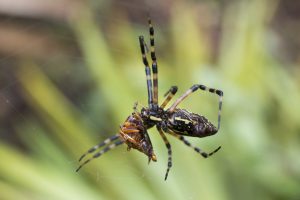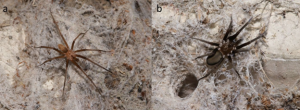It seems like I’m always finding a unique spider in the house. Whether I’ve been summoned to remove it from the premises or by a chance encounter. It is no surprise to me that there are more than 250 species of spiders found in Florida. In fact, I figured there were quite a bit more. Some spiders are aggressive, some have extreme patience, and others aren’t even spiders at all. Continue reading for some interesting facts about a few of the most common spiders in North Florida.

A golden silk orb-weaver spider with captured prey. Photo Credit: Tyler Jones, University of Florida.
Golden Silk Orb Weaver (Trichonephila Clavipes)
I grew referring to orb weavers as banana spiders. I guess I wasn’t the only one, because banana spiders are another one of their common names. Orb weavers are known for making big webs and producing really strong silk. Female spiders usually have other, smaller spiders occupying their webs. Male orb weavers are roughly a quarter the size of their female counterparts. In addition to the orb weaver couple on the web, small kleptoparasitic dewdrop spiders in the genus Argyrodes can be found eating bits and pieces of prey left behind.
Southern House Spider (Kukulcania hibernalis)
The brown recluse is a spider we can live without. Fortunately, they’re not very common in Florida. However, male southern house spiders are often mistaken for recluse spiders. If you want to be sure, just count the number of eyes. House spiders have eight eyes, whereas brown recluses only have six. Female southern house spiders don’t look like recluses or male southern house spiders at all. The females are dark brown with thick bodies and males are lanky and light brown. These spiders build thick webs in wall corners and the edges of windows.

Male (a) and female (b) southern house spider (Kukulcania hibernalis) The male is light brown with long pedipalps, while the female is a dark velvety brown with shorter pedipalps.
Photo Credit: Erin C. Powell, FDACS-DPI
Harvestmen (Opiliones Family)
Everyone has seen a “daddy long legs” spider or at least we think we have. We may sometimes refer to harvestmen as “daddy long legs” spider, but they’re not even spiders at all. Harvestmen are classified as arachnids like spiders, scorpions, and mites, but they come from a different family (Opiliones). They only have one body segment, instead of two, they have no venom glands, and they can’t produce silk. And if anyone tells you they are the most venomous spider but can’t bit humans because their mouths are too small – well you know what to tell them. And there is such a thing as a cellar spider (Pholcus spp.) that has long legs, two body segments, and is also referred to as a “daddy long legs”, but what’s the fun in that.
We could go on and on about all the different spiders that can be found in and around your home, or not. If you are interested in other common spiders in Florida, then you should check out the UF/IFAS publication “An Introduction to Some Common and Charismatic Florida Spiders”. Then you’ll know exactly what’s lurking around the corner.
- Is a Limequat a Lime or a Kumquat? - December 26, 2025
- Gardening in the Panhandle LIVE! Program Summary: Pests of Florida Lawns and Landscape Plants - May 28, 2025
- Fun Facts About Ferns - April 30, 2025
